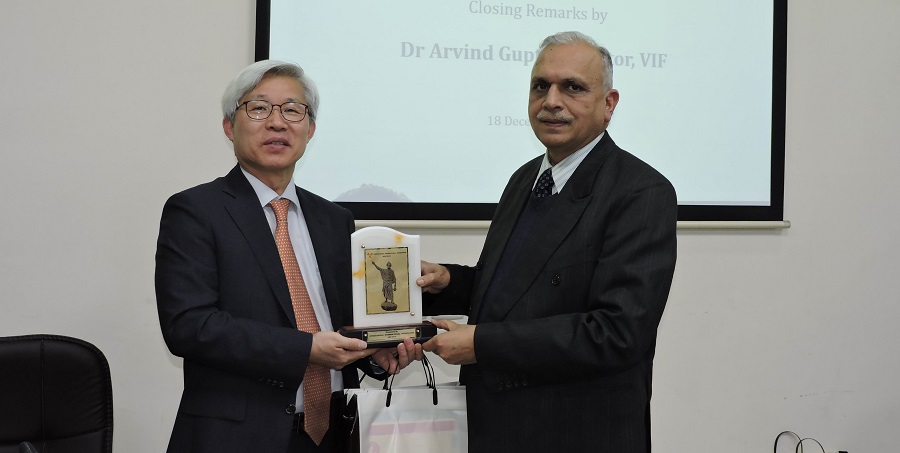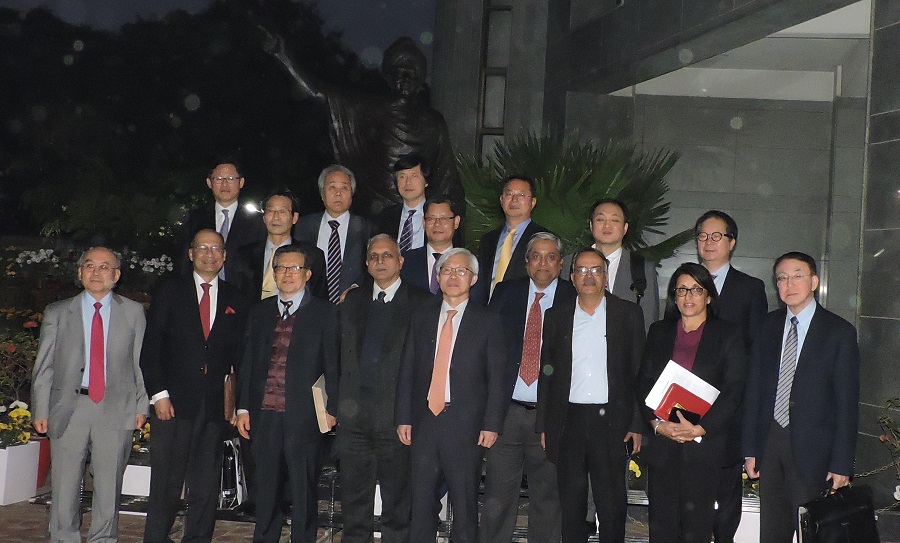

The Vivekananda International Foundation held a maiden interaction with an eminent delegation of Sejong Institute from South Korea on 18 December 2017. The interaction explored various facets of current global, regional and bilateral dynamics between India and South Korea. Some of the salient points raised are discussed below.
India-South Korea Partnership: Need for More Visibility
India-South Korea partnership has seen a new momentum under Prime Minister Modi. During his visit to South Korea in May 2015, India- South Korea relationship was elevated to the level of ‘Special Strategic Partnership.’ There are strong people to people contacts with about 19 connecting flights per week. Energy is an important sector of cooperation with a Civil Nuclear Cooperation Agreement. However, the Comprehensive Economic Partnership Agreement (CEPA) needs to be expanded as India has a limited export basket and thus needs better access to Korean market. After the POSCO fiasco in Orissa, the Modi administration needs to better address Korean concerns.
The ‘Korea Plus’ initiative, launched in 2016, has already been availed by 100 plus companies. Korean investment is increasing with Kia Motors in collaboration with Hyundai investing Rs. 10,000 crore in Andhra Pradesh. South Korean giant Lotte Confectionery acquired Havmor Ice Cream Ltd in India for Rs. 1020 crore in 2017, entering the ice cream snacks segment as well as expanding its business network across India.
Overall, there are well-established strategic platforms, but the strategic content needs to be expanded. Similar to economic cooperation, security cooperation needs to be enlarged to maintain free and open global commons that are essential to both countries. There is great scope for cooperation in defense manufacturing shipbuilding etc., though India’s procurement policies need to be streamlined. Indian and South Korean competencies in fields like space and communication are also highly complementary. A flagship project such as a Korean-built Industrial Park would greatly raise the profile of the partnership. Also, regular high level visits need to be expanded.

Increasing Belligerence of North Korea: India’s Unambiguous Support for South Korea
The current crisis in the Korean peninsula, caused by the continuous and wreckless testing of the nuclear weapons and missiles by the North Korean regime in the recent months has made the global security situation worse. The role of US, China, Japan, Russia and regional powers has come into sharp focus. India too is affected by the actions of the North Korean regime. The North Korean regime has in the past supplied missile technology to Pakistan and also received help from the latter it in the development of its nuclear weapons. India has unambiguously condemned North Korea and a similar gesture of recognition of India’s concerns by the South Korean side would greatly boost the partnership.
President Moon Jae-in laid out his 5-point peace proposal in his address in Berlin in July 2017. They are peaceful Korean peninsula free from the threat of nuclear weapons and war, pursuit of the denuclearization of the Korean Peninsula that guarantees the security of the North Korean regime, establishment of a permanent peace regime, renewed economic cooperation on the Korean Peninsula and pursuit of nonpolitical exchange and cooperation projects by separating it from the political and military situation.
Geopolitics in Indo-Pacific: Both Strategic and Economics Driven
Rise of the notion of Indo-Pacific is a response to the shift in geo-political trend in Asia Pacific region. While accommodating the ambitions of China has given traction to the geopolitical terminology of ‘Indo-Pacific’, growing linkages between the Indian and the Pacific Oceans also serve to propel the center of gravity of the global economy to the east. Indian Ocean is major route for global trade including energy trade with 80 percent trade that crosses it being extra-regional. Freedom of navigation on the high seas as well as adherence to the UN Convention of the Law of the Seas is an important pillar of India’s Maritime Policy.
India has a central location in the Indian Ocean. However, tensions over China’s aggressions, North Korea, insurgencies, terrorism, fragility of democratic institutions, and a web of multilateral and polycentric institutions complicate the scenario with numerous factors at play. India response is of caution and reluctance to be drawn into any formal alliances. There serves as great commonality between Indian and South Korea as both seek to escape the tussle between Beijing and Washington.

Uncertainty Regarding the US
Trump became the first US president to reiterate the notion of Indo-Pacific with India as the linchpin of US pivot strategy. While the US is definitely not in decline, there is uncertainty regarding the US policy in the Indo-Pacific region. Yet the new US administration recognizes the centrality of the region in its economic and strategic wellbeing.
Impact of Chinese Style Great Power Diplomacy
Xi Jinping formally proposed the ‘Great Power Diplomacy with Chinese Characteristics’ during the 19th Party Congress in October 2017. This has led to more proactive and assertive policies against Deng Xiaoping’s adage of ‘hide your capabilities, bide your time’. However, there is no consensus on what are the ‘Chinese characteristics’ in China. There are two lines of debate around Chinese characteristics - one centers on the continuation of China’s historical traditions and culture, and the other on reflecting Chinese interests in its foreign policy. In implementation, it comprises of influence and reform of global governance and ‘a community of shared future’, as evidenced by the Belt & Road Initiative that traverses more than 70 countries.
The emphasis is on creating an image that China as a great power would be different from other traditional western powers like the US or Great Britain. However, China has various domestic problems to confront along with the international reactions that its policies would trigger. Thus, much depends on how the US policies would continue under Trump.
Use of Economic Sanctions by China
China’s fast economic growth has led to utilization of economic sanctions to achieve its foreign and security interests. It provides free trade agreements and aid to incentivize countries to be in harmony with China. It coerces its neighboring countries to reduce their military activities. However, due to limitations on using aid, a limited number of countries are targeted to be made an example for others. For example, South Korea is targeted with low intensity sanctions on tourism. However, the tensions take some time to resolve as evidenced by China-Norway normalizing their relations after six years. While, it influences other countries to concede, in long term it has negative impact on China as it translates government-to-government tensions into civilian negativity. Thus diversification of trade relations is necessary but it is difficult to change the economics of East Asia. Multilateralism therefore remains a viable option to regulate the problem of China’s imposied unilateral economic sanctions.
The interaction was appraised by both think tanks as highly useful with efforts to increase similar interactions in the future.
Links:
[1] https://www.vifindia.org/event/report/2017/january/05/interaction-with-visiting-south-korean-delegation-of-sejong-institute
[2] http://www.facebook.com/sharer.php?title=Interaction with Visiting South Korean Delegation of Sejong Institute&desc=&images=https://www.vifindia.org/sites/default/files/Picture1_4.jpg&u=https://www.vifindia.org/event/report/2017/january/05/interaction-with-visiting-south-korean-delegation-of-sejong-institute
[3] http://twitter.com/share?text=Interaction with Visiting South Korean Delegation of Sejong Institute&url=https://www.vifindia.org/event/report/2017/january/05/interaction-with-visiting-south-korean-delegation-of-sejong-institute&via=Azure Power
[4] whatsapp://send?text=https://www.vifindia.org/event/report/2017/january/05/interaction-with-visiting-south-korean-delegation-of-sejong-institute